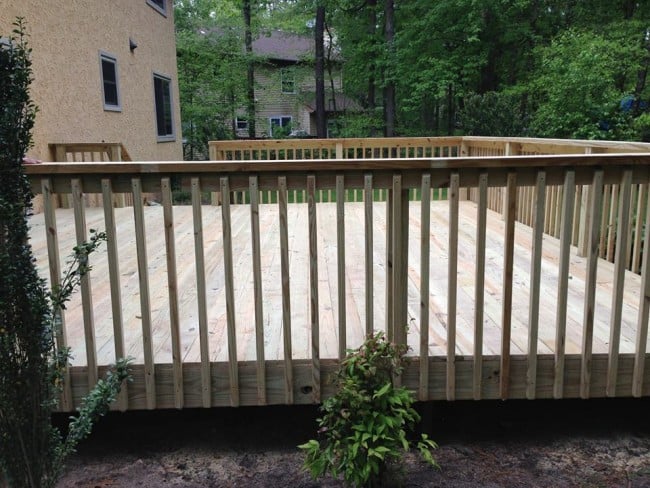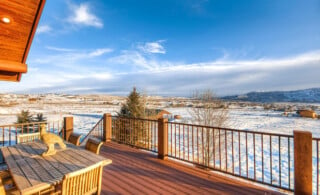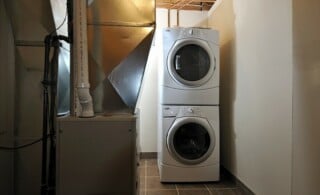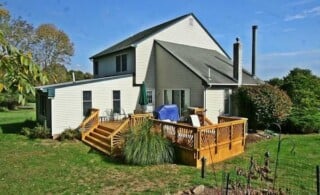
Decks have gone from being a novelty to very common. This is because better wood treatments make wood more durable. While some decks are made with traditional redwood (which has natural preservatives in it), the majority of decks are now made from pressure-treated pine.
Is Deck Maintenance Necessary?
Most decks are made of pressure-treated pine. Good quality-treated pine will last forty years or so before there is any substantial decay. However, discoloration and splintering can begin after only a few months. For this reason, most people take on a regular cycle of maintenance. Failure to do so won’t cause your deck to rot, but your deck will most certainly become discolored, and the surface will become rough and prone to splinters.
Do New Decks Need to be Sealed?
Yes. To ensure the deck continues to look good with minimal splintering and discoloration, the deck should be sealed as soon as it becomes stabilized within its environment. This usually means waiting a few weeks after the deck is completed before sealing. The cost to seal a deck averages between $500 and $1,100.
What Will Happen to a Poorly Maintained Deck?
Many people never treat and seal their decks. Untreated decks don’t fall down or rot away quickly. Nothing dramatic happens. They will simply get dirty and the surface will become much rougher much sooner. Splinters are a common problem with wood decks. Another hazard is slick surfaces. Much of the “dirt” we see on a poorly maintained deck is actually living organisms. Just like the algae and moss that grow on rocks next to a stream, the organic material growing on a deck can make the deck very slippery when wet. Cleaning and sealing a deck kills, removes and slows the return of organic buildup.
What Type of Maintenance is Recommended?
Approximately once a year, the deck should be checked for loose boards and protruding nails, thoroughly cleaned and resealed. Cleaning involves the removal of dirt, algae, moss and other organic matter. Resealing is accomplished applying a clear or semi-clear liquid sealant to all exposed surfaces. Homeowners can do any of these tasks themselves, but often don’t do them as well as a professional. You should hire a deck professional to ensure your deck gets the best care.
Many professional firms now offer this service. Prices and quality vary considerably. At the bottom end of that scale are a lot of firms that don’t know much about what they are doing. Choose an experienced, high-quality firm.
What is Good Deck Maintenance?
Preparation
The process begins with clearing the deck of furniture, toys, etc. Then cover fragile plants. Next, sweep deck free of large debris. Check carefully for loose boards and nails that stick up. Make any necessary repairs. Before beginning the cleaning process, make sure no children have access to the area.
Cleaning Products
In accordance with the directions that come with the cleaning solutions, it may be necessary to hose down the deck and surrounding area before applying cleaning solutions. The water can also help dilute any chemicals that may inadvertently come into contact with plants and grass. Even with mild solutions, care must be taken to limit the amount of solution that gets on nearby plants and grass. Many solutions contain bleach, which is toxic to plants when in concentrated form. The solutions can be brushed onto the deck using a broom or can be sprayed on with a power washer under low pressure.
After waiting the directed length of time for the chemicals to do their work, the deck should be thoroughly rinsed. This is the step where more power can be particularly helpful, as water under pressure more effectively rinses out both dirt and chemicals. However, too much pressure can gouge wood or cause the grain to become exaggerated. Within wood, the visible grain marks differences in density and hardness. Part of each grain is relatively soft wood. This softer wood can be rinsed away if too much pressure is used. At still higher pressures, even the harder parts of the grain can be damaged.
Sealing
Once the deck is dry, put down tarps to protect plants, air conditioners and other items on which you don’t want to get sealant. The level of protection needed depends in part on how you are going to apply the sealant. Sealant can be brushed on, rolled on with a paint roller, or sprayed on.
Spraying is the fastest by far, but is the hardest to control. Some sealants have color in them and will stain surfaces to which they are applied. Sealants are also rough on plants. While most plants won’t be damaged by getting hit with wafting over-spray, direct hits can do real damage.
Sealants come in either water- or oil-based formulas. Professional sealants, which are typically superior, are oil-based. Some sealants contain stain to tint the color of the deck. Sealants with stain don’t always deliver a uniform color across the wood, so try some in an out-of-the-way spot to make sure the results match your expectations. Good quality sealants contain ultra-violet sunlight protection to reduce the damaging effects of the sun.
Alternatives to Traditional Decking Materials
There are new decking material options. Several companies make new decking materials that don’t splinter and don’t require painting or sealing. Most are made of plastic or a blend of wood and plastic. While widespread experience with the products is just now occurring, results look very promising. More expensive initially than the common wood products used today, they offer large savings over time due to reduced maintenance costs.
 The Ins & Outs of Mobile Home Repair
The Ins & Outs of Mobile Home Repair  Deck Maintenance Checklist
Deck Maintenance Checklist  DIY Guide: How To Service Your Furnace
DIY Guide: How To Service Your Furnace  Should You Build a Deck or Hire a Pro?
Should You Build a Deck or Hire a Pro?  How to Hide Pesky Carpet Seams
How to Hide Pesky Carpet Seams 

I’m grateful for your advice about the importance of regular cycle of deck maintenance to prevent deck to rot, discolored, and the prone to splinters. We just moved into our new home, and we have a lovely wooden deck. We’ll take your advice of having a regular maintenance to prevent the deck from getting rough. Thanks for the tips!